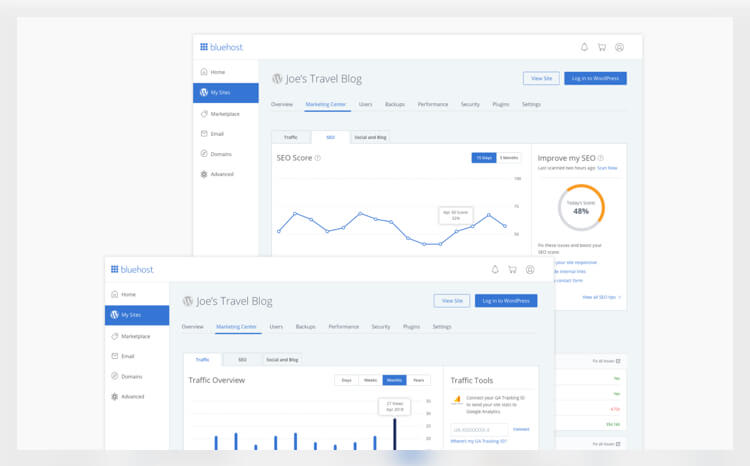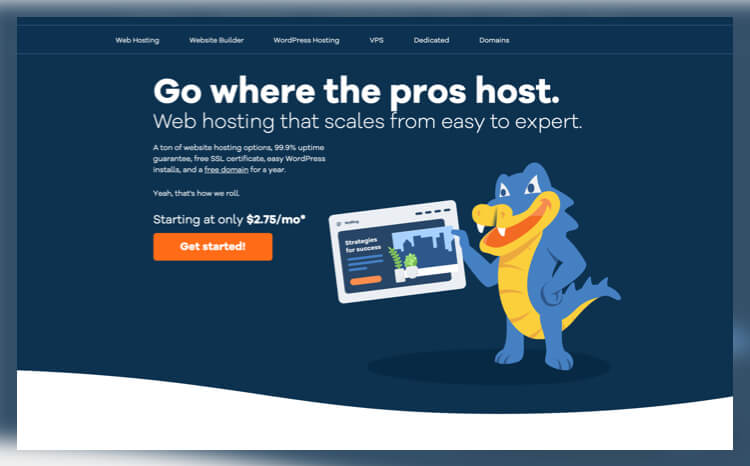

- 1-click WordPress installation
- Get $150+ in advertising offers
- 30-day money-back guarantee






- Unlimited bandwidth, 20-140GB disk space
- 30-day money-back guarantee
- Support: 24/7 chat


- Free domain & SSL certificate
- 1-click WordPress installation
- Choose from 5,000+ themes




- Fast turbo servers
- Anytime money-back guarantee
- Support: 24/7 phone, chat, email


- Free domain registration
- Servers optimized for WordPress sites
- Black Friday Sale in effect
WordPress Hosting Explained
The creation of WordPress began in 2003 as an offshoot of a popular blogging application known as b2. It was further developed as a blogging platform, and it soon overtook its predecessor. More recently, the company has expanded into a full-featured web content system for websites of all types, offering dynamic WordPress options to the masses.
Today, over 68 million websites run on WordPress, and users cite several reasons for the award-winning platform's popularity. Their software is free and open-source, which allows a multitude of developers to contribute unique themes, widgets and plug-in modules to customize websites and provide powerful yet easy-to-use administrative tools.
Understanding the Best WordPress Hosting Options
Understanding WordPress hosting first requires some general knowledge about web hosting. All of the websites on the Internet are operated from specialized computers known as servers. Although it is possible to own and operate a server, the cost, training and time commitment required make it prohibitive and inefficient for most individuals and many businesses. To mitigate these costs, companies known operate dozens, hundreds or even thousands of servers from a central location. They then lease their servers and server resources to individuals and businesses at affordable rates.
WordPress hosting is very similar to web hosting. The only difference is that the servers all meet the minimum hardware and software requirements to run the this hosting platform. This allows the platform to integrate seamlessly into the server and process data requests through the Internet quickly and efficiently. Because the demand for WordPress hosting is so high, nearly every reputable company offers WordPress hosting, and several options are available for a range of requirements and budgets. Someone who just wants to put a personal blog online may choose to go with a shared WordPress plan while large businesses often opt to lease one or more entire servers.
WordPress Hosting Compatibility
To install and operate it, a host's servers must meet a few prerequisites. To run the 3.1 version, servers must meet the following software requirements: PHP version 4.3 or later and MySQL version 4.1.2 or later. For 3.2, the requirements are PHP version 5.2.4 or later and MySQL version 5.0.15 or later.
In addition to the above software, experts recommend using either Apache or NGINX Web servers running the optional Apache mod_rewrite module.
How to Choose the Best WordPress Hosting Provider for You
Choosing a hosting provider is a big step because your website will rely on and be restrained by the host's servers and service. Several factors can be evaluated and compared when choosing a host, including all of the following:
- Reliability – Your host should guarantee at least 99.9 percent website uptime, and pages should load quickly on all browsers.
- Ease of use – It should be a simple process to remotely access your website through a major control panel application.
- Customer support – Your host should be available to answer your questions and solve problems 24 hours per day via multiple channels, such as phone, email and online chat.
- Hosting packages – A package should be available that closely matches your specific requirements.
- Price – The price of can vary widely between different platforms. When determining which company is right for you, you will need to consider the features you require and your budget. Most provide useful comparison tools that allow you to quickly evaluate each package that is offered. Some of the common packages are explained below:
- Shared hosting – Is the lowest tier available, but for many users, it is all that is needed. In this package, a single server is partitioned for use by several clients who share the server's resources as they are needed. This type is the least secure and the least reliable, but it is also very affordable.
- E-commerce hosting – Is a specialized package developed for those who plan to conduct sales through a WordPress website. It includes several features, such as an electronic shopping cart and credit card processing.
- VPS hosting – A virtual private server (VPS) is a shared server that has had its resources fully partitioned for two or more clients. This ensures that a pre-established amount of resources is always available for your use, and no crossover occurs between clients. VPS hosting is best for businesses, websites that experience heavy traffic and websites that require unique software installations.
- Dedicated hosting – Dedicated hosting is on the top tier of packages. With this package, you lease an entire server for your own use. The server may be managed by your own IT team, or it may be managed by the provider for an additional fee. This type is the most expensive, but it also offers the most flexibility.
Our Top 3 Picks
- 1

 good8.4
good8.4 Comprehensive hosting plans with perks includedComprehensive hosting plans with perks includedRead Bluehost Review
Comprehensive hosting plans with perks includedComprehensive hosting plans with perks includedRead Bluehost ReviewWith more than 2 million websites internationally, Bluehost is one of the most popular web hosting services in the industry. And that’s not hard to understand when you look at what’s being offered. 1-click WordPress installation, 24/7 expert support from trained professionals, and a 30-day money-back guarantee are just a few of the reasons we’re so impressed by Bluehost.
Bluehost Pros & Cons
PROS
Outstanding customer supportSuite of added web toolsUnlimited bandwidth and storageCONS
Have to pay for site transferA lot of upselling - 2

 good8.3
good8.3 Web and cloud hosting with all the perksWeb and cloud hosting with all the perksRead HostGator Review
Web and cloud hosting with all the perksWeb and cloud hosting with all the perksRead HostGator ReviewNot too many people will fail to recognize the familiar friendly gator, the mascot of HostGator. The service is one of the most prevalent in the country, and it has the perks to keep customers coming back. HostGator kicks things off with a 45-day money-back guarantee, 24/7 live chat customer support, and a solid 99.9% uptime guarantee.
HostGator Pros & Cons
PROS
Free domain for a year99.9% uptime guaranteeLots of tools and plans to choose fromCONS
VPS is only Linux-basedSo many options can be overwhelming - 3

 very good8.7
very good8.7 A comprehensive selection of hosting plansA comprehensive selection of hosting plansRead GoDaddy Review
A comprehensive selection of hosting plansA comprehensive selection of hosting plansRead GoDaddy ReviewYou’ll no doubt be familiar with GoDaddy, the somewhat snarky, slightly scandalous, and seriously silly hosting service that combines humor and website hosting in a professional and reliable way. Between that and perks like affordable pricing, 99.9% uptime, and a free SSL certificate with most plans, GoDaddy is a great deal.
GoDaddy Pros & Cons
PROS
One-click install for Drupal, WordPress, JoomlaGlobal data centersLoads of hosting plans to chooseCONS
Content isn’t transferred over themesPricing disclosure is not transparent



